Impact of Short-Term and Prolonged (Multi-Year) Droughts on Tree Mortality at the Individual Tree and Stand Levels
Abstract
1. Introduction
2. Results
2.1. Mortality of Individual Trees and Larger Tree Groups
2.2. Climatic Characteristics Analysis
2.3. Long-Term Drought Analysis
2.4. Analysis of Annual Mortality Rates
2.5. Correlation Between Drought Impact and Mortality of Individual Trees and Larger Tree Groups
3. Discussion
4. Materials and Methods
4.1. Study Area
4.2. Data Preparation
4.3. Quantification of Climatic Characteristics
4.4. Drought Index Quantification
4.5. Statistical Analysis
5. Conclusions
Supplementary Materials
Author Contributions
Funding
Data Availability Statement
Conflicts of Interest
References
- Wankmüller, F.J.P.; Delval, L.; Lehmann, P.; Baur, M.J.; Cecere, A.; Wolf, S.; Or, D.; Javaux, M.; Carminati, A. Global influence of soil texture on ecosystem water limitation. Nature 2024, 635, 631–638. [Google Scholar] [CrossRef] [PubMed]
- Lindh, M.; Zhang, L.; Falster, D.; Franklin, O.; Brännström, A. Plant diversity and drought: The role of deep roots. Ecol. Model. 2014, 290, 85–93. [Google Scholar] [CrossRef]
- Jiang, Y.; Marchand, W.; Rydval, M.; Matula, R.; Janda, P.; Begović, K.; Thom, D.; Fruleux, A.; Buechling, A.; Pavlin, J.; et al. Drought resistance of major tree species in the Czech Republic. Agric. For. Meteorol. 2024, 348, 109933. [Google Scholar] [CrossRef]
- ITMN—International Tree Mortality Network. Towards a global understanding of tree mortality. New Phytol. 2025, 245, 2377–2392. [Google Scholar] [CrossRef]
- Adams, H.D.; Guardiola-Claramonte, M.; Barron-Gafford, G.A.; Villegas, J.C.; Breshears, D.D.; Zou, C.B.; Troch, P.A.; Huxman, T.E. Temperature sensitivity of drought-induced tree mortality portends increased regional die-off under global-change-type drought. Proc. Natl. Acad. Sci. USA 2009, 106, 7063–7066. [Google Scholar] [CrossRef]
- Baković, Z. Vulnerability of forest ecosystems under the influence of climate changes through the prism of occurrence and effects of weather extremes. In Proceedings of the 11th International Conference “Risk and Safety Engineering”, Kopaonik, Serbia, 25–27 January 2016; Higher Technical School of Vocational Studies: Novi Sad, Serbia, 2016; pp. 320–331. (In Serbian). [Google Scholar]
- Zhang, Q.; Shao, M.A.; Jia, X.; Wei, X. Relationship of climatic and forest factors to drought- and heat-induced tree mortality. PLoS ONE 2017, 12, e0169770. [Google Scholar] [CrossRef] [PubMed]
- Senf, C.; Seidl, R. Mapping the forest disturbance regimes of Europe. Nat. Sustain. 2020, 4, 63–70. [Google Scholar] [CrossRef]
- Moravec, V.; Markonis, Y.; Rakovec, O.; Svoboda, M.; Trnka, M.; Kumar, R.; Hanel, M. Europe under multi-year droughts: How severe was the 2014–2018 drought period? Environ. Res. Lett. 2021, 16, 034062. [Google Scholar] [CrossRef]
- Gazol, A.; Camarero, J.J. Compound climate events increase tree drought mortality across European forests. Sci. Total. Environ. 2022, 816, 151604. [Google Scholar] [CrossRef]
- Češljar, G.; Đorđević, I.; Eremija, S.; Marković, M.; Gagić Serdar, R.; Lučić, A.; Čule, N. Early Warning Signs in Tree Crowns as a Response to the Impact of Drought. Forests 2025, 16, 405. [Google Scholar] [CrossRef]
- Spinoni, J.; Barbosa, P.; De Jager, A.; Mc Cormick, N.; Naumann, G.; Vogt, J.V.; Magni, D.; Masante, D.; Mazzeschi, M. A new global database of meteorological drought events from 1951 to 2016. J. Hydrol. Reg. Stud. 2019, 22, 100593. [Google Scholar] [CrossRef]
- Bennett, A.C.; Mcdowell, N.G.; Allen, C.D.; Andersonteixeira, K.J. Larger trees suffer most during drought in forests worldwide. Nat. Plants 2015, 1, 15139. [Google Scholar] [CrossRef]
- Navarro-Cerrillo, R.M.; González-Moreno, P.; Ruiz-Gómez, F.J.; Sánchez-Cuesta, R.; Gazol, A.; Camarero, J.J. Drought stress and pests increase defoliation and mortality rates in vulnerable Abies pinsapo forests. For. Ecol. Manag. 2022, 504, 119824. [Google Scholar] [CrossRef]
- de la Serrana, R.G.; Vilagrosa, A.; Alloza, J.A. Pine mortality in southeast Spain after an extreme dry and warm year: Interactions among drought stress, carbohydrates and bark beetle attack. Trees 2015, 29, 1791–1804. [Google Scholar] [CrossRef]
- Boczoń, A.; Kowalska, A.; Ksepko, M.; Sokołowski, K. Climate Warming and Drought in the Bialowieza Forest from 1950–2015 and Their Impact on the Dieback of Norway Spruce Stands. Water 2018, 10, 1502. [Google Scholar] [CrossRef]
- Colangelo, M.; Camarero, J.J.; Borghetti, M.; Gentilesca, T.; Oliva, J.; Redondo, M.A.; Ripullone, F. Drought and Phytophthora are associated with the decline of oak species in southern Italy. Front. Plant Sci. 2018, 9, 1595. [Google Scholar] [CrossRef] [PubMed]
- Ugarković, D.; Jazbec, A.; Seletković, I.; Tikvić, I.; Paulić, V.; Ognjenović, M.; Marušić, M.; Potočić, N. Silver Fir Decline in Pure and Mixed Stands at Western Edge of Spread in Croatian Dinarides Depends on Some Stand Structure and Climate Factors. Sustainability 2021, 13, 6060. [Google Scholar] [CrossRef]
- Cailleret, M.; Dakos, V.; Jansen, S.; Robert, E.M.R.; Aakala, T.; Amoroso, M.M.; Antos, J.A.; Bigler, C.; Bugmann, H.; Caccianaga, M.; et al. Early-Warning Signals of Individual Tree Mortality Based on Annual Radial Growth. Front. Plant Sci. 2019, 9, 1964. [Google Scholar] [CrossRef]
- Brodrick, P.G.; Asner, G.P. Remotely sensed predictors of conifer tree mortality during severe drought. Environ. Res. Lett. 2017, 12, 115013. [Google Scholar] [CrossRef]
- Williams, A.P.; Allen, C.D.; Millar, C.I.; Swetnam, T.W.; Michaelsen, J.; Still, C.J.; Leavitt, S.W. Forest responses to increasing aridity and warmth in the southwestern United States. Proc. Natl. Acad. Sci. USA 2010, 107, 21289–21294. [Google Scholar] [CrossRef]
- Pollastrini, M.; Bussotti, F.; Iacopetti, G.; Puletti, N.; Mattioli, W.; Selvi, F. Forest tree defoliation and mortality in Tuscany (central Italy) connected to extreme drought and heat wave in the 2017 summer: A preliminary report. In Proceedings of the 20th EGU General Assembly, EGU2018, Vienna, Austria, 8–13 April 2018. [Google Scholar]
- Ognjenović, M.; Seletković, I.; Potočić, N.; Marušić, M.; Tadić, M.P.; Jonard, M.; Rautio, P.; Timmermann, V.; Lovreškov, L.; Ugarković, D. Defoliation Change of European Beech (Fagus sylvatica L.) Depends on Previous Year Drought. Plants 2022, 11, 730. [Google Scholar] [CrossRef] [PubMed]
- Hänsel, S.; Hoy, A.; Brendel, C.; Maugeri, M. Record summers in Europe: Variations in drought and heavy precipitation during 1901–2018. Int. J. Climatol. 2022, 42, 6235–6257. [Google Scholar] [CrossRef]
- Rebetez, M.; Mayer, H.; Dupont, O.; Schindler, D.; Gartner, K.; Kropp, J.P.; Menzel, A. Heat and drought 2003 in Europe: A climate synthesis. Ann. For. Sci. 2006, 63, 569–577. [Google Scholar] [CrossRef]
- Fischer, E.M.; Seneviratne, S.I.; Vidale, P.L.; Lüthi, D.; Schär, C. Soil moisture–atmosphere interactions during the 2003 European summer heat wave. J. Clim. 2007, 20, 5081–5099. [Google Scholar] [CrossRef]
- Barriopedro, D.; Fischer, E.M.; Luterbacher, J.; Trigo, R.M.; García-Herrera, R. The hot summer of 2010: Redrawing the temperature record map of Europe. Science 2011, 332, 220–224. [Google Scholar] [CrossRef]
- Flach, M.; Sippel, S.; Gans, F.; Bastos, A.; Brenning, A.; Reichstein, M.; Mahecha, M.D. Contrasting biosphere responses to hydrometeorological extremes: Revisiting the 2010 western Russian heatwave. Biogeosciences 2018, 16, 6067–6085. [Google Scholar] [CrossRef]
- Van Lanen, H.A.J.; Laaha, G.; Kingston, D.G.; Gauster, T.; Ionita, M.; Vidal, J.-P.; Vlnas, R.; Tallaksen, L.M.; Stahl, K.; Hannaford, J.; et al. Hydrology needed to manage droughts: The 2015 European case. Hydrol. Process. 2016, 30, 3097–3104. [Google Scholar] [CrossRef]
- Hoy, A.; Hansel, S.; Skalak, P.; Ustrnul, Z.; Bochniček, O. The extreme European summer of 2015 in a long-term perspective. Int. J. Climatol. 2016, 37, 943–962. [Google Scholar] [CrossRef]
- Ionita, M.; Tallaksen, L.M.; Kingston, D.G.; Stagge, J.H.; Laaha, G.; Van Lanen, H.A.J.; Scholz, P.; Chelcea, S.M.; Haslinger, K. The European 2015 drought from a climatological perspective. Hydrol. Earth Syst. Sci. 2017, 21, 1397–1419. [Google Scholar] [CrossRef]
- Hari, V.; Rakovec, O.; Markonis, Y.; Hanel, M.; Kumar, R. Increased future occurrences of the exceptional 2018–2019 Central European drought under global warming. Sci. Rep. 2020, 10, 12207. [Google Scholar] [CrossRef]
- Peters, W.; Bastos, A.; Ciais, P.; Vermeulen, A. A historical, geographical and ecological perspective on the 2018 European summer drought. Philos. Trans. R. Soc. B 2020, 375, 20190505. [Google Scholar] [CrossRef]
- Rakovec, O.; Samaniego, L.; Hari, V.; Markonis, Y.; Moravec, V.; Thober, S.; Hanel, M.; Kumar, R. The 2018–2020 multi-year drought sets a new benchmark in Europe. Earth’s Future 2022, 10, e2021EF002394. [Google Scholar] [CrossRef]
- Liu, Y.; Song, H.; An, Z.; Li, Q.; Leavitt, S.W.; Büntgen, U.; Cai, Q.; Liu, R.; Fang, C.; Sun, C.; et al. Recent centennial drought on the Tibetan Plateau is outstanding within the past 3500 years. Nat. Commun. 2025, 16, 1311. [Google Scholar] [CrossRef]
- Hoover, D.L.; Smith, W.K. The growing threat of multiyear droughts. Science 2025, 387, 246–247. [Google Scholar] [CrossRef]
- Chen, L.; Brun, P.; Buri, P.; Fatichi, S.; Gessler, A.; McCarthy, M.J.; Pellicciotti, F.; Stocker, B.; Karger, D.N. Global increase in the occurrence and impact of multiyear droughts. Science 2025, 387, 278–284. [Google Scholar] [CrossRef]
- RHSS—Republic Hydrometeorological Service of Serbia. Anual Climate Characteristics for the Territory of Serbia. Republic Hydrometeorological Service of Serbia, Belgrade. Available online: https://www.hidmet.gov.rs/eng/meteorologija/klimatologija_produkti.php (accessed on 25 March 2025).
- Češljar, G.; Jovanović, F.; Brašanac-Bosanac, L.; Đorđević, I.; Mitrović, S.; Eremija, S.; Ćirković-Mitrović, T.; Lučić, A. Impact of an Extremely Dry Period on Tree Defoliation and Tree Mortality in Serbia. Plants 2022, 11, 1286. [Google Scholar] [CrossRef] [PubMed]
- Seidling, W. Signals of summer drought in crown condition data from the German Level I network. Eur. J. For. Res. 2007, 126, 529–544. [Google Scholar] [CrossRef]
- Pretzsch, H.; Grams, T.; Häberle, K.H.; Pritsch, K.; Bauerle, T.; Rötzer, T. Growth and mortality of Norway spruce and European beech in monospecific and mixedspecies stands under natural episodic and experimentally exten ded drought. Results of the KROOF throughfall exclusion experiment. Trees 2020, 34, 957–970. [Google Scholar] [CrossRef]
- Vejpustková, M.; Čihák, T.; Fišer, P. The increasing drought sensitivity of silver fir (Abies alba Mill.) is evident in the last two decades. J. For. Sci. 2023, 69, 67–79. [Google Scholar] [CrossRef]
- Camarero, J.J.; Gazol, A. Will silver fir be under higher risk due to drought? A comment on Walder et al. (2021). For. Ecol. Manag. 2022, 503, 119826. [Google Scholar] [CrossRef]
- Obladen, N.; Dechering, P.; Skiadaresis, G.; Tegel, W.; Keßler, J.; Höllerl, S.; Kaps, S.; Hertel, M.; Dulamsuren, C.; Seifert, T.; et al. Tree mortality of European beech and Norway spruce induced by 2018–2019 hot droughts in central Germany. Agric. For. Meteorol. 2021, 307, 108482. [Google Scholar] [CrossRef]
- Kunz, J.; Löffler, G.; Bauhus, J. Minor European broadleaved tree species are more drought-tolerant than Fagus sylvatica but not more tolerant than Quercus petraea. For. Ecol. Manag. 2018, 414, 15–27. [Google Scholar] [CrossRef]
- ICP Forests—International Co-Operative Programme on Assessment and Monitoring of Air Pollution Effects on Forests. Available online: http://icp-forests.net/page/programme-2 (accessed on 30 March 2025).
- Ionita, M.; Dima, M.; Nagavciuc, V.; Scholz, P.; Lohmann, G. Past megadroughts in central Europe were longer, more severe and less warm than modern droughts. Commun. Earth Environ. 2021, 2, 61. [Google Scholar] [CrossRef]
- Hanel, M.; Rakovec, O.; Markonis, Y.; Máca, P.; Samaniego, L.; Kyselý, J.; Kumar, R. Revisiting the recent European droughts from a long-term perspective. Sci. Rep. 2018, 8, 9499. [Google Scholar] [CrossRef] [PubMed]
- Bakke, S.J.; Ionita, M.; Tallaksen, L.M. The 2018 northern European hydrological drought and its drivers in a historical perspective. Hydrol. Earth Syst. Sci. 2020, 24, 5621–5653. [Google Scholar] [CrossRef]
- Hansen, J.; Ruedy, R.; Sato, M.; Lo, K. Global surface temperature change. Rev. Geophys. 2010, 48, RG4004. [Google Scholar] [CrossRef]
- Levinson, D.H.; Fettig, C.J. Climate Change: Updates on Recent Global and United States Temperature Anomalies and Impacts to Water, Forests, and Environmental Health. In Climate Change and Global Public Health; Pinkerton, K.E., Rom, W.N., Eds.; Springer International Publishing: Cham, Germany, 2021; pp. 51–74. [Google Scholar] [CrossRef]
- NIDIS—National Integrated Drought Information System. Defining Short- and Long-Term Drought. Available online: https://www.drought.gov/what-is-drought/drought-timescales-short-vs-long-term-drought#overview (accessed on 15 April 2025).
- Knutzen, F.; Averbeck, P.; Barrasso, C.; Bouwer, L.M.; Gardiner, B.; Grünzweig, J.M.; Hänel, S.; Haustein, K.; Johannessen, M.R.; Kollet, S.; et al. Impacts and damages of the European multi-year drought and heat event 2018–2022 on forests. EGUsphere 2023, 25, 77–117. [Google Scholar] [CrossRef]
- Samaniego, L.; Thober, S.; Kumar, R.; Wanders, N.; Rakovec, O.; Pan, M.; Zink, M.; Sheffield, J.; Wood, E.F.; Marx, A. Anthropogenic warming exacerbates European soil moisture droughts. Nat. Clim. Change 2018, 8, 421–426. [Google Scholar] [CrossRef]
- Aalbers, E.E.; van Meijgaard, E.; Lenderink, G.; de Vries, H.; van den Hurk, B.J.J.M. The 2018 west-central European drought projected in a warmer climate: How much drier can it get? Nat. Hazards Earth Syst. Sci. 2023, 5, 1921–1946. [Google Scholar] [CrossRef]
- Pollastrini, M.; Puletti, N.; Selvi, F.; Iacopetti, G.; Bussotti, F. Widespread crown defoliation after a drought and heat wave in the forests of Tuscany (Central Italy) and their recovery—A case study from summer 2017. Front. For. Glob. Change 2019, 2, 74. [Google Scholar] [CrossRef]
- Rita, A.; Camarero, J.J.; Nolè, A.; Borghetti, M.; Brunetti, M.; Pergola, N.; Serio, C.; Vicente-Serrano, S.M.; Tramutoli, V.; Ripullone, F. The impact of drought spells on forests depends on site conditions: The case of 2017 summer heat wave in southern Europe. Glob. Change Biol. 2019, 26, 851–863. [Google Scholar] [CrossRef] [PubMed]
- Brun, P.; Psomas, A.; Ginzler, C.; Thuiller, W.; Zappa, M.; Zimmermann, N.E. Large-scale early-wilting response of central European forests to the 2018 extreme drought. Glob. Change Biol. 2020, 26, 7021–7035. [Google Scholar] [CrossRef] [PubMed]
- Schuldt, B.; Buras, A.; Arend, M.; Vitasse, Y.; Beierkuhnlein, C.; Damm, A.; Gharun, M.; Grams, T.E.E.; Hauck, M.; Hajek, P.; et al. A first assessment of the impact of the extreme 2018 summer drought on central European forests. Basic Appl. Ecol. 2020, 45, 86–103. [Google Scholar] [CrossRef]
- Bussotti, F.; Papitto, G.; Di Martino, D.; Cocciufa, C.; Cindolo, C.; Cenni, E.; Bettini, D.; Iacopetti, G.; Pollastrini, M. Defoliation, Recovery and Increasing Mortality in Italian Forests: Levels, Patterns and Possible Consequences for Forest Multifunctionality. Forests 2021, 12, 1476. [Google Scholar] [CrossRef]
- Rohner, B.; Kumar, S.; Liechti, K.; Gessler, A.; Ferretti, M. Tree vitality indicators revealed a rapid response of beech forests to the 2018 drought. Ecol. Indic. 2021, 120, 106903. [Google Scholar] [CrossRef]
- Bussotti, F.; Bettini, D.; Carrari, E.; Selvi, F.; Pollastrini, M. Climate change in progress: Observations on the impacts of drought events on Tuscan forests. J. Silvic. For. Ecol. 2023, 20, 1–9. [Google Scholar] [CrossRef]
- Wang, Y.; Rammig, A.; Blickensdörfer, L.; Wang, Y.; Zhu, X.X.; Buras, A. Species-specific responses of canopy greenness to the extreme droughts of 2018 and 2022 for four abundant tree species in Germany. Sci. Total Environ. 2025, 958, 177938. [Google Scholar] [CrossRef]
- EEA—European Environmental Agency. Drought Impact on Ecosystems in Europe. Available online: https://www.eea.europa.eu/en/analysis/indicators/drought-impact-on-ecosystems-in-europe?activeAccordion=ecdb3bcf-bbe9-4978-b5cf-0b136399d9f8 (accessed on 27 March 2025).
- Djurdjević, V.; Stosic, B.; Tošić, M.; Lazić, I.; Putniković, S.; Stosic, T.; Tošić, I. Analysis of recent trends and spatiotemporal changes of droughts over Serbia using high-resolution gridded data. Atmos. Res. 2024, 304, 107376. [Google Scholar] [CrossRef]
- Peltier, D.M.P.; Fell, M.; Ogle, K. Legacy effects of drought in the southwestern United States: A multi-species synthesis. Ecol. Monogr. 2016, 86, 312–326. [Google Scholar] [CrossRef]
- Forzieri, G.; Girardello, M.; Ceccherini, G.; Spinoni, J.; Feyen, L.; Hartmann, H.; Beck, P.S.A.; Camps-Valls, G.; Chirici, G.; Mauri, A.; et al. Emergent vulnerability to climate-driven disturbances in European forests. Nat. Commun. 2021, 12, 1081. [Google Scholar] [CrossRef]
- Senf, C.; Buras, A.; Zang, C.S.; Rammig, A.; Seidl, R. Excess forest mortality is consistently linked to drought across Europe. Nat. Commun. 2020, 11, 6200. [Google Scholar] [CrossRef] [PubMed]
- Leuschner, C. Drought response of European beech (Fagus sylvatica L.)—A review. Perspect. Plant Ecol. Evol. Syst. 2020, 47, 125576. [Google Scholar] [CrossRef]
- NFI—National Forest Inventory of the Republic of Serbia 2023. Available online: https://upravazasume.gov.rs/oglasna-tabla/naredbu-o-proglasenju-prirodne-nepogode-i-merama-zastite-i-sanacije-suma-ostecenih-vetrolomima-i-vetroizvalama-2/ (accessed on 28 March 2025).
- RHSS—Republic Hydrometeorological Service of Serbia. Basic Climate Characteristics for the Territory of Serbia. Republic Hydrometeorological Service of Serbia, Belgrade. Available online: https://www.hidmet.gov.rs/eng/meteorologija/klimatologija_srbije.php (accessed on 26 February 2025).
- Vicente-Serrano, S.M.; Beguería, S.; López-Moreno, J.I. A Multi-scalar drought index sensitive to global warming: The Standardized Precipitation Evapotranspiration Index—SPEI. J. Clim. 2010, 23, 1696–1718. [Google Scholar] [CrossRef]
- Standardized Precipitation Evapotranspiration Index (SPEI) Database. Available online: http://sac.csic.es/spei/database.html (accessed on 25 March 2025).
- Eichhorn, J.; Roskams, P.; Potočić, N.; Timmermann, V.; Ferretti, M.; Mues, V.; Szepesi, A.; Durrant, D.; Seletković, I.; Schröck, H.-W.; et al. Part IV Visual Assessment of Crown Condition and Damaging Agents. In ICP Forests Manual; Version 2020-3; Thünen Institute of Forest Ecosystems: Eberswalde, Germany, 2020; pp. 5–54. Available online: https://storage.ning.com/topology/rest/1.0/file/get/9995547265?profile=original (accessed on 30 March 2025).
- Sheil, D.; Burslem, D.F.R.P.; Alder, D. The interpretation and misinterpretation of mortality rate measures. J. Ecol. 1995, 83, 331–333. [Google Scholar] [CrossRef]
- Lewis, S.L.; Phillips, O.L.; Sheil, D.; Vinceti, B.; Baker, T.R.; Brown, S.; Graham, A.W.; Higuchi, N.; Hilbert, D.W.; Laurance, W.F.; et al. Tropical forest tree mortality, recruiting and turnover rates: Calculation, interpretation and comparison when census intervals vary. J. Ecol. 2004, 92, 929–944. [Google Scholar] [CrossRef]

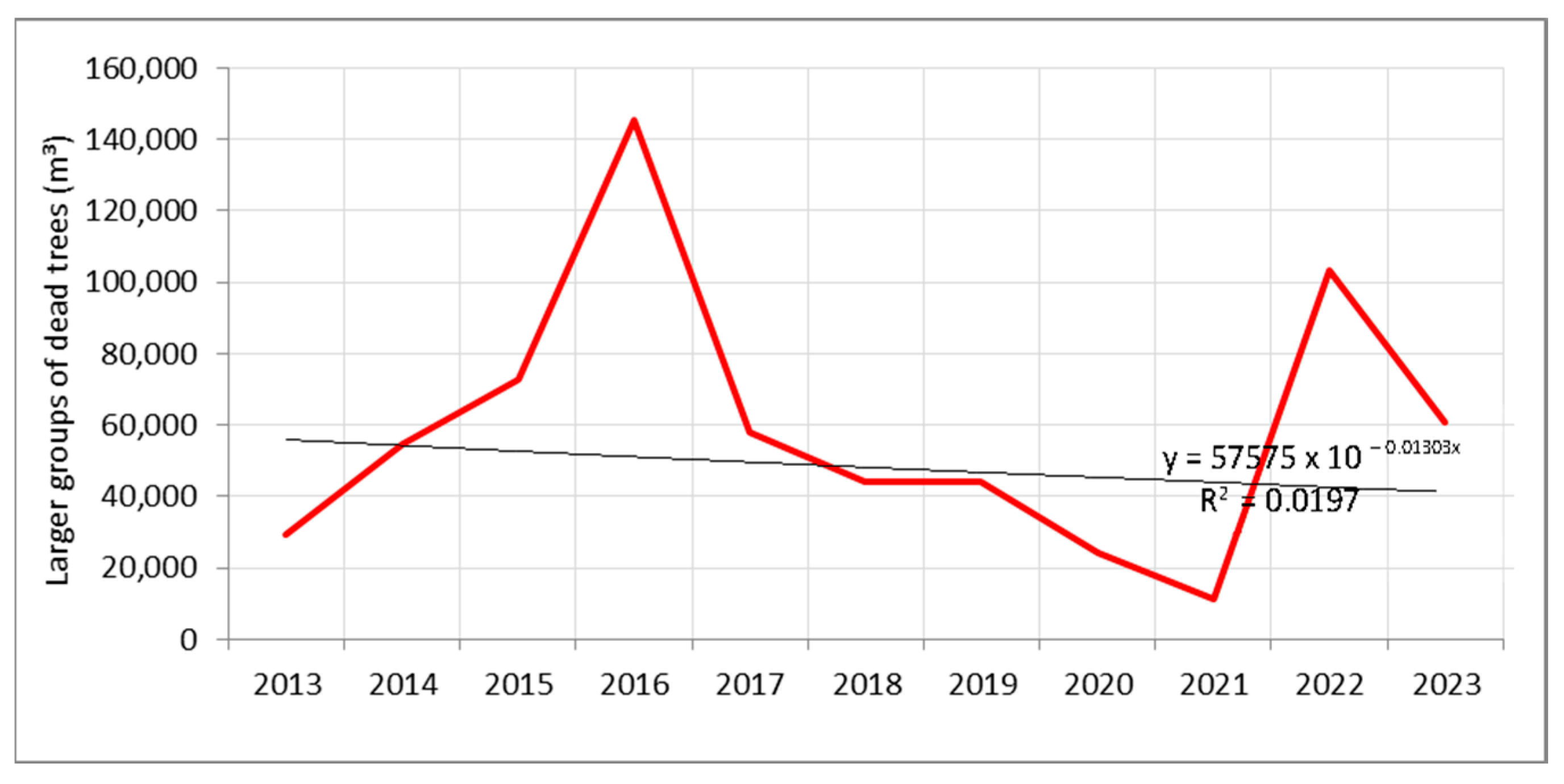
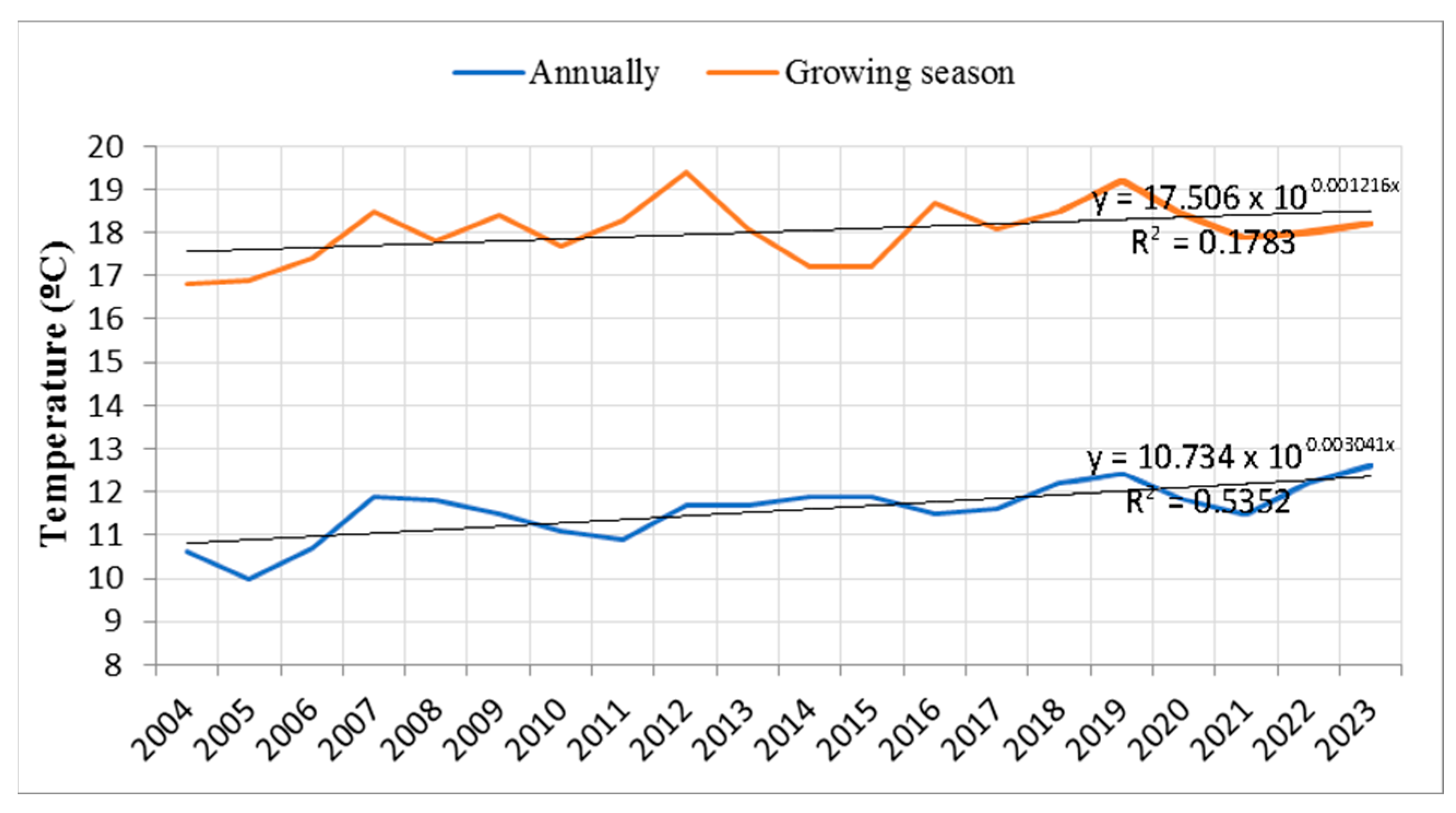


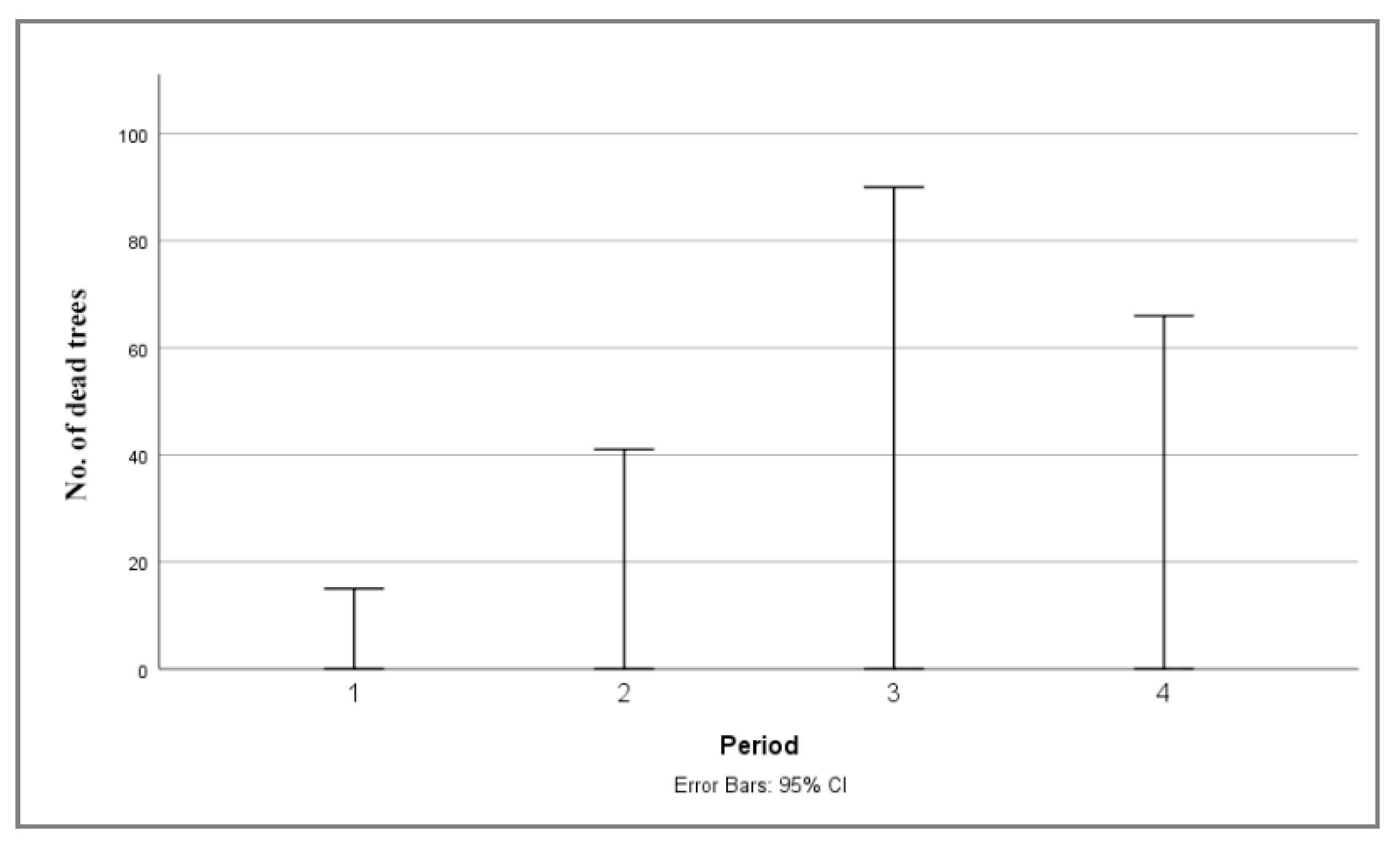
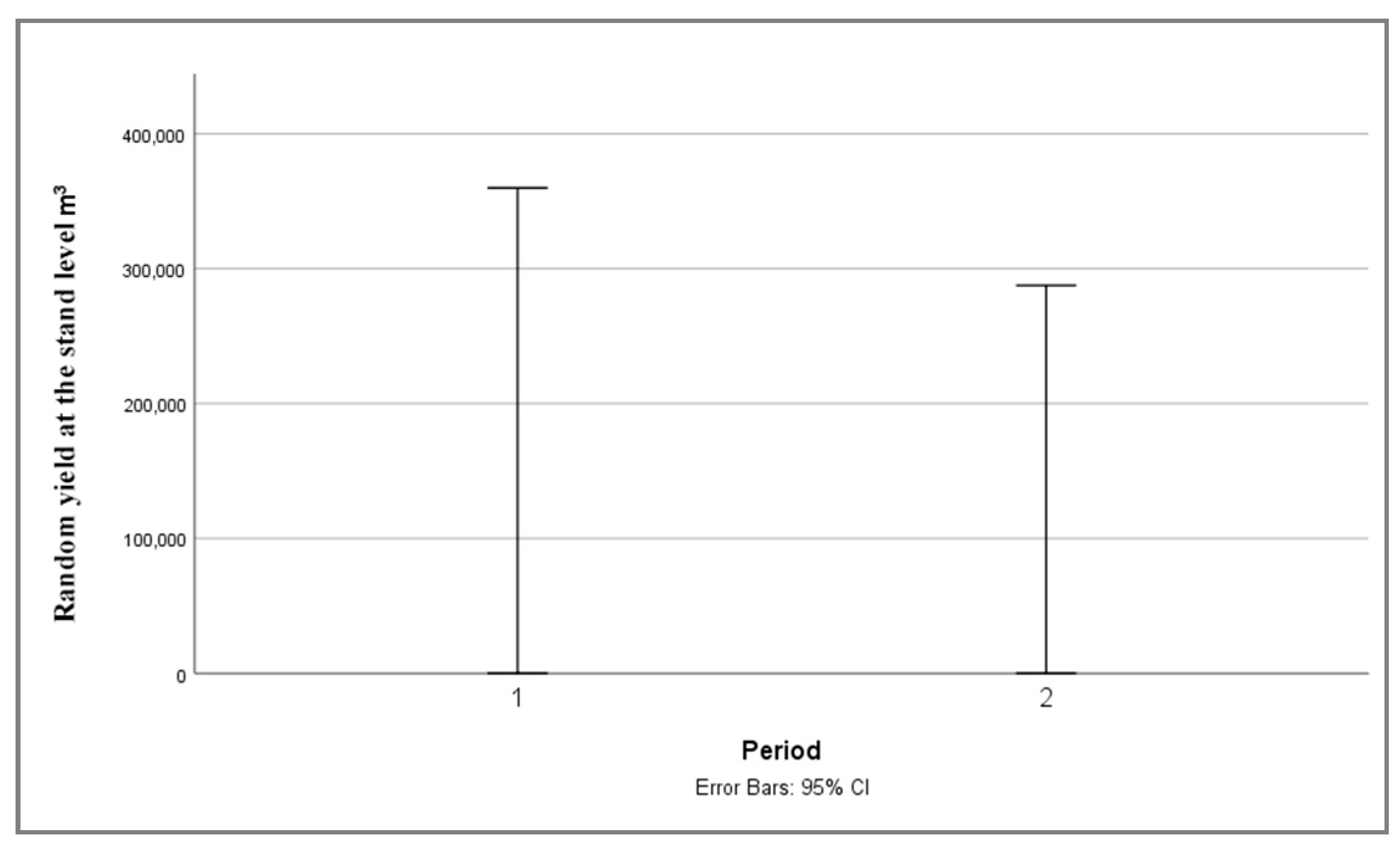
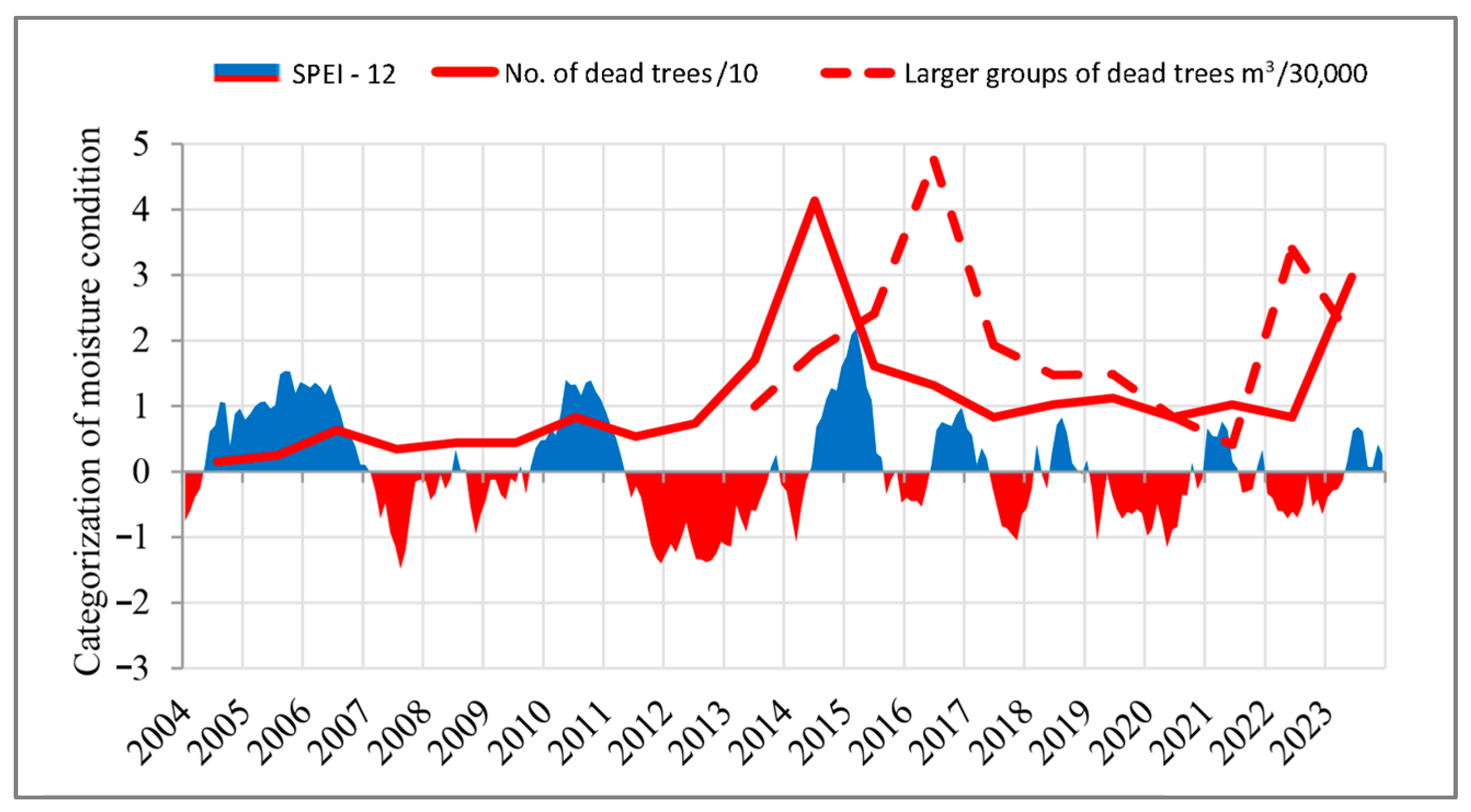

| Observation Period | Average Mortality Rate |
|---|---|
| 2004–2008 | 0.0010 |
| 2009–2013 | 0.0029 |
| 2014–2018 | 0.0061 |
| 2019–2023 | 0.0045 |
| Period of Observation | N | M | MAD | MIN | MAX | Mean Rank | Test Statistics | Results | |
|---|---|---|---|---|---|---|---|---|---|
| 2004–2008 | 1 | 5 | 0.0010 | 0.0005 | 0.0000 | 0.0020 | 3.5 | Kruskal–Wallis H | 11.749 |
| 2009–2013 | 2 | 5 | 0.0025 | 0.0012 | 0.0014 | 0.0061 | 9.7 | df | 3 |
| 2014–2018 | 3 | 5 | 0.0044 | 0.0027 | 0.0027 | 0.0143 | 15.4 | Asymp. Sig. (p-value) | 0.008 |
| 2019–2023 | 4 | 5 | 0.0034 | 0.0017 | 0.0027 | 0.0101 | 13.4 | ||
| Period of Observation | N | M | MAD | MIN | MAX | Mean Rank | Test Statistics | Results | |
|---|---|---|---|---|---|---|---|---|---|
| 2014–2018 | 1 | 5 | 57,955.69 | 23,641.7 | 43,927.43 | 145,168.9 | 6.4 | Kruskal–Wallis H | 0.884 |
| 2019–2023 | 2 | 5 | 44,208.21 | 25,746.93 | 11,092.87 | 103,279.7 | 4.6 | df | 1 |
| Asymp. Sig. | 0.347 | ||||||||
Disclaimer/Publisher’s Note: The statements, opinions and data contained in all publications are solely those of the individual author(s) and contributor(s) and not of MDPI and/or the editor(s). MDPI and/or the editor(s) disclaim responsibility for any injury to people or property resulting from any ideas, methods, instructions or products referred to in the content. |
© 2025 by the authors. Licensee MDPI, Basel, Switzerland. This article is an open access article distributed under the terms and conditions of the Creative Commons Attribution (CC BY) license (https://creativecommons.org/licenses/by/4.0/).
Share and Cite
Češljar, G.; Baković, Z.; Đorđević, I.; Eremija, S.; Lučić, A.; Živanović, I.; Konatar, B. Impact of Short-Term and Prolonged (Multi-Year) Droughts on Tree Mortality at the Individual Tree and Stand Levels. Plants 2025, 14, 1904. https://doi.org/10.3390/plants14131904
Češljar G, Baković Z, Đorđević I, Eremija S, Lučić A, Živanović I, Konatar B. Impact of Short-Term and Prolonged (Multi-Year) Droughts on Tree Mortality at the Individual Tree and Stand Levels. Plants. 2025; 14(13):1904. https://doi.org/10.3390/plants14131904
Chicago/Turabian StyleČešljar, Goran, Zvonimir Baković, Ilija Đorđević, Saša Eremija, Aleksandar Lučić, Ivana Živanović, and Bojan Konatar. 2025. "Impact of Short-Term and Prolonged (Multi-Year) Droughts on Tree Mortality at the Individual Tree and Stand Levels" Plants 14, no. 13: 1904. https://doi.org/10.3390/plants14131904
APA StyleČešljar, G., Baković, Z., Đorđević, I., Eremija, S., Lučić, A., Živanović, I., & Konatar, B. (2025). Impact of Short-Term and Prolonged (Multi-Year) Droughts on Tree Mortality at the Individual Tree and Stand Levels. Plants, 14(13), 1904. https://doi.org/10.3390/plants14131904





